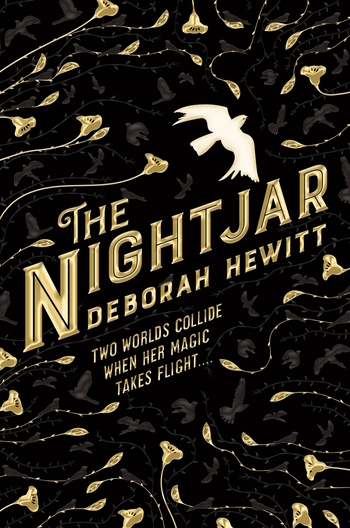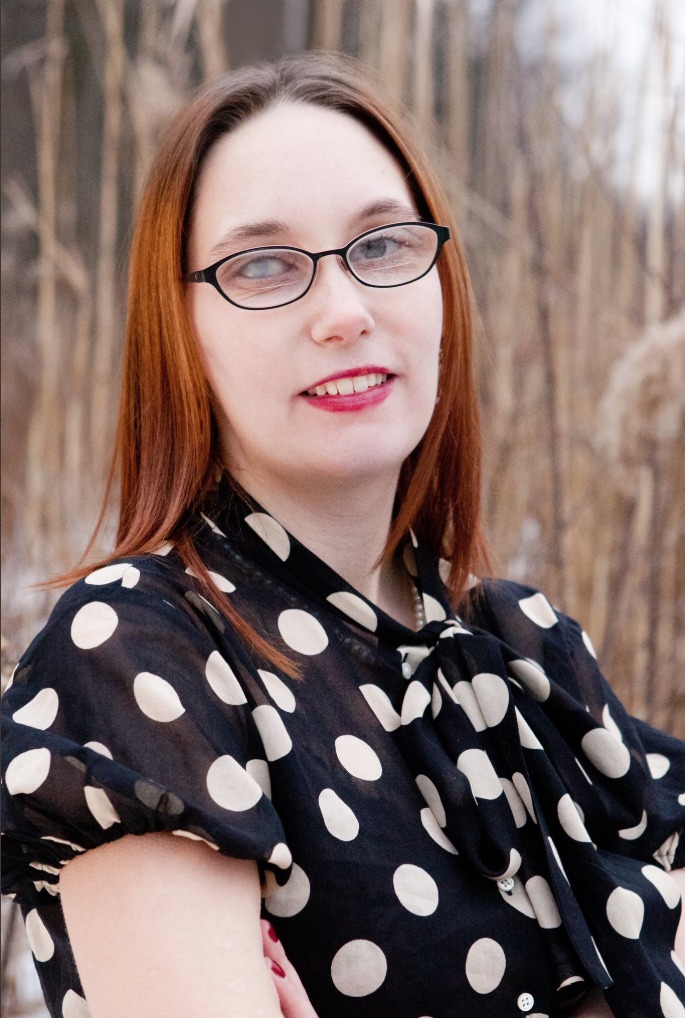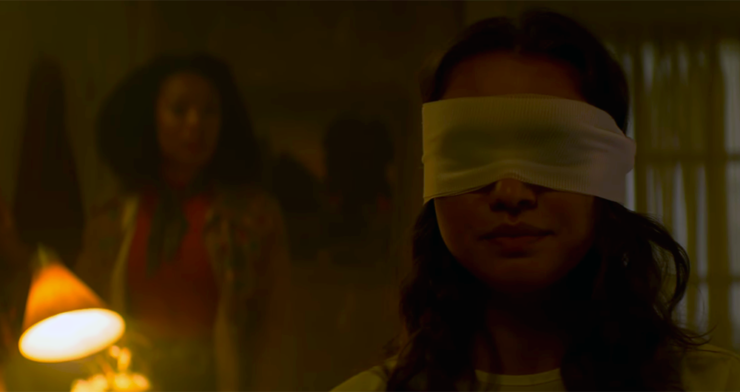In the fourth episode of the second half of Chilling Adventures of Sabrina Season 1, Ros (during a flash forward helpfully provided by a tarot reader) has been cured of her blindness through surgery. She is so grateful, and so glad to no longer be a blind person, that she decides to give back.
She decides to volunteer at a “home for the blind.” (More on this later, I promise)
She arrives in a small room to find a preteen wearing a stark white blindfold. Presumably, this is where the blind people are kept. (Again, more on this later.)
It’s during this scene (which we’ll come back to later) that she utters my least favorite question, which I hear on average at least once a week.
“I’m so sorry. Can I ask…? Did it happen suddenly? I hope you don’t mind me talking about this, but how did you go blind?”
Ros’ tone is soft. Gentle. Uncompromisingly “polite” even while asking the most probing of questions.
What happened to you? How did you go blind? Was it sudden?
What happened to your eyes?
Eyes.
They are the biological tool with which people see. They are a delicate body part which must be cared for. They are called the windows into the soul.
Eyes are at the very core of talking about blindness, of course, because they are the source of the problem.
There are as many ways to be blind as there are to be people. Thousands of ways in which the eye can be damaged, destroyed, or debilitated.
Like I’ve said before, part of the reason sighted people fear blindness (and by extension, I feel, blind people) so much, is because we never talk about what it’s really like to be blind. There’s little in the way of accurate representation to make us feel anything other than terror when it’s suggested that we will not be able to see.
When we are children, we fear the dark—it is instinct. Even I as a blind child would insist upon a nightlight, or a cassette tape to lull me to sleep. There is definitely something primal in this fear of the dark.
Blindness, more than any other disability, evokes a fear of the unknown. Perhaps it’s because sighted people rely on visual cues to survive. Perhaps it is because as children we hear stories about how what we can’t see can haunt us or even kill us.
It’s why in horror literature, the use of blindness is so frequent. Holes where eyes should be, cataracted “corpse eyes” like my own; there are versions of blindness which only exist in the pages of a horror book, and they are almost without exception deeply damaging to actual blind people, and the perception of the eyes that they either have, or do not have, and the experiences that they have out in the real world as a consequence of these depictions.
The Second Half of Sabrina’s Season Doubled the H*ck Down.
When last we left Ros in the first half of Season 1, Sabrina’s best friend was going blind. In the first installment of this column, I asked questions about how she would prepare for her blind life.
In the newest episodes, we’ve barely seen her when she shows up in the tarot flash forward episode, pulling the blind justice card.
Because of course the blind girl has to pull the blind justice card. Anyway. Ros was considering surgery to fix her sight, and the tarot reader tells her that this is a big decision with consequences.
Buy the Book


The Nightjar
Ros’ surgery goes perfectly in her flash forward. She can see!
So back to that opening snapshot I gave you.
Ros goes to a Home for the Blind.
It is dank, and weird, and spooky (and of course it’s a spooky flash forward, so okay I can sort of forgive that). But think about it. Close your eyes and really think about what you think a home for the blind would look like.
Does it look scary to you?
Does it look cluttered? Full of furniture a blind person cannot see? Does it seem dark?
That’s what the creators of Sabrina think blind living is like.
I don’t think they’re trying to comment on the deeply unsettling history of disabled institutionalization. If you want to see a real horrorshow, go research places like Willowbrook, places where families would leave their disabled children.
Places where people could forget their disabled children entirely.
But this isn’t commentary, this is full acceptance of the trope that being blind is itself a terror, and that the eyes of the blind can thus be used to evoke dread and horror in the viewer.
When Ros asks the dreaded question of how she went blind, the girl responds rapidly. Her voice grows raspy and full of barbs, and when she removes the white blindfold, she accuses Ros of having taken her eyes—of rendering her blind.
The pinnacle of fear in this sequence is not that Ros’ father, a man of God, used his influence to take someone else’s eyes.
The pinnacle of horror is that there are sockets where the girl’s eyes should be.
Cataracts as Horror
When I was a little girl on the playground, I had a classmate who made the evil eye sign at me. A classmate who, after a while, must have been told by a parent that my eye marked me as something Other.
He’d never had a problem until this moment. He’d never stared at me like I was something evil. Never screamed for me not to touch him.
But now he did.
And that was when I started flinching.
I flinch when I see that the White Walkers on Game of Thrones mostly appear to have cataracts for eyes. I flinch when seers blink and they can see the dead through their white eyes. I flinch when Nell in Netflix’s The Haunting of Hill House suddenly has eyes like mine, in some nightmare scenario that the haunting has engendered.
I flinch because I know that when someone who doesn’t know me locks eyes with me across a room, the first thing they think of probably isn’t the ocean, a waterfall, or a storm bent upon the water, as the word “cataract” originally signified. No, what they think of when they see my eye is death.
While yes, the eye does cloud over after death, while yes, the body does change, it is not the same as a cataract, and yet the media has shifted our perception.
I don’t know why we’ve decided that a cataract marks someone as evil, but I do know that media portrays eyes not just as the windows to the soul—but as a marker. As a cheat sheet for whether or not someone is mystical, or even evil, by simply looking someone in the eye.
So okay, you’re reading this and you think “so what if your eyes are like a zombie’s eyes?”
But I’ll flip that around.
What if creators picked only green eyes, or blue eyes, or brown eyes to resemble the eyes of the evil dead?
What if, instead of every time a child saw my eye on public transit and asked me if I was a witch, that reaction was reserved for people who have pupils in both eyes?
What if I never had to answer the question “What happened to you” again?
I think there’s a very deep connection between the media that we see, and how we interact with people in public. I think that when we reserve the cataract for the sole purpose of evoking fear, we’re saying something about what we as a society should do when we see one.
Look into my eye, and tell me—is there evil there? Because when I see it, all I see is me.

Elsa Sjunneson-Henry is a gimlet made from feminism and snark. She’s a deafblind speculative fiction author, and she writes disability focused nonfiction as well. Her work has appeared in Uncanny, Fireside, Tor.com, CNN, and The Boston Globe, and she is a 2019 Hugo Award finalist for Best Fan Writer, as well as a Best Semiprozine Hugo finalist for her work as an editor on Fireside Magazine and Uncanny Magazine’s Disabled People Destroy Science Fiction Special Issue. She writes from a dragon lair in NJ, and can be found on the web @snarkbat and snarkbat.com










